1993 BUICK PARK AVENUE warning
[x] Cancel search: warningPage 226 of 340
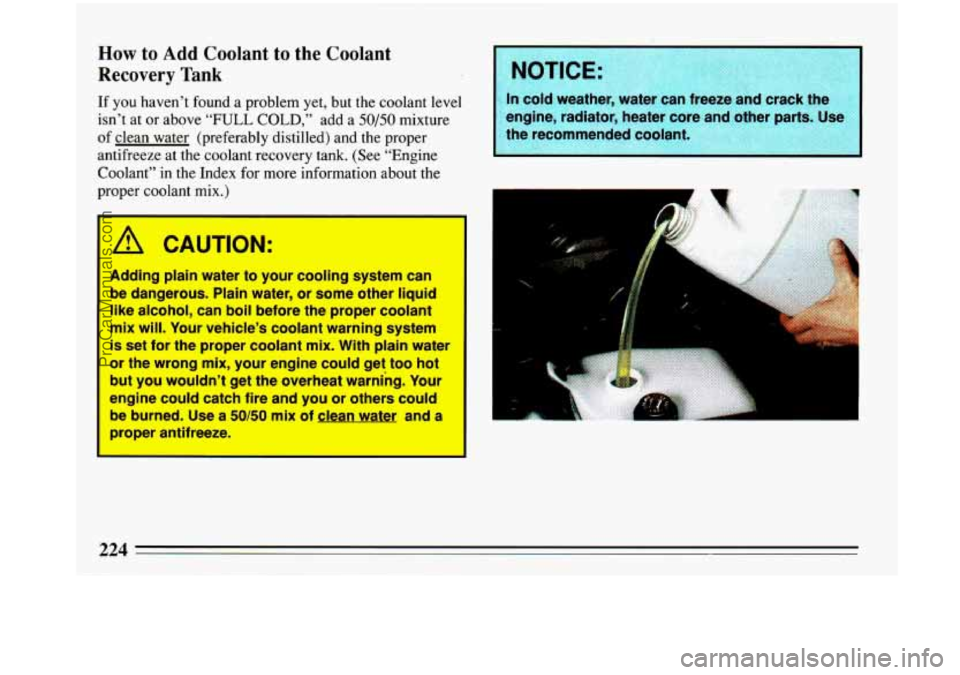
How to Add Coolant to the Coolant
Recovery
Tank
If you haven’t found a problem yet, but the coolant level In cold weather, water can free
isn’t at or above “FULL COLD,” add a 50/50 mixture
of clean water (preferably distilled) and the proper
antifreeze at the coolant recovery tank. (See “Engine
Coolant’’ in the Index for more information about the
proper coolant mix.)
I A CAUTION:
I Adding plain water to your cooling system can
be dangerous. Plain water, or some other liquid
like alcohol, can boll befare the proper coolant
mix will. Your vehicle’s coolant warning system
is set for the groper coolant mix. With plain water
.of the wrung mix, your engine could get too hot
but you wouldn’t get the overheat warning. Your
engine could catch fire and you or others could
be burned. Use a 50/50 mix of Glean water and a
proper antifreeze.
I
I
I
ProCarManuals.com
Page 227 of 340
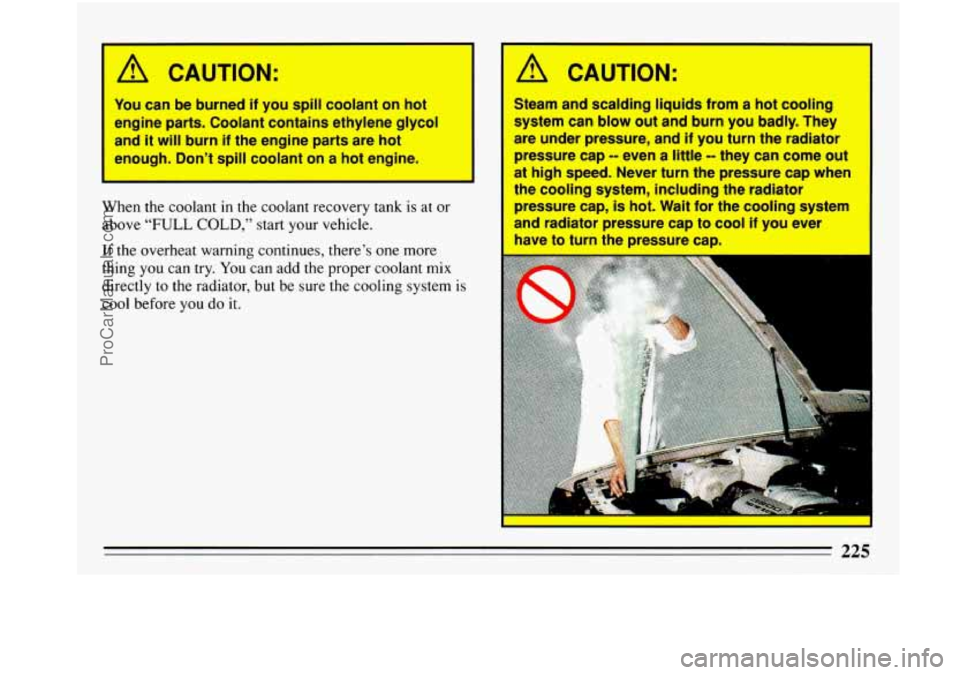
A CAUTION: A CAUTION:
You can be burned if you spill cootant on hot
engine parts. Coolant contains ethylene glycol
and it will burn if the engine parts are hot
enough. Don’t spill coolant on a hot engine.
When the coolant in the coolant recovery tank is at or
above
“FULL COLD,” start your vehicle.
If the overheat warning continues, there’s one more
thing you can try.
You can add the proper coolant mix
directly
to the radiator, but be sure the cooling system is
cool before
you do it.
Steam and scalding liquids from a hot cooling
system can blow out and burn you badly. They
are under pressure, and if you turn the radiator
pressure cap
-- even a little -- they can come out
at high speed. Never turn the pressure cap when
e cooling system, including the radiator
pressure cap, is hot. Wait for the cooling system
and radiator pressure cap to cool
if you ever
have
to turn the pressure cap.
L
L
ProCarManuals.com
Page 231 of 340
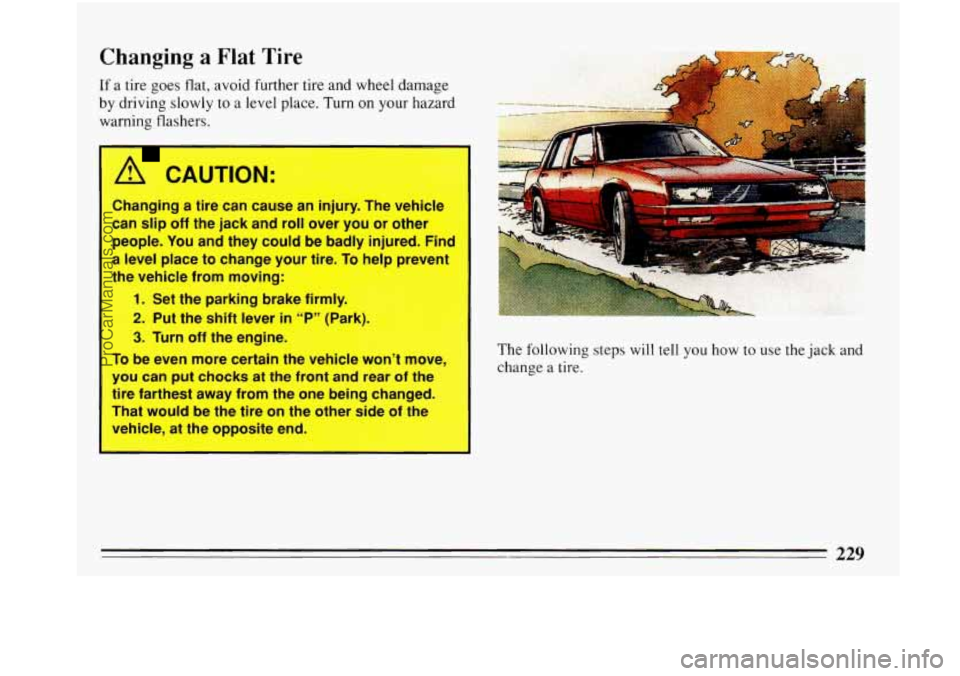
Changing a Flat Tire
If a tire goes flat, avoid further tire and wheel damage
by driving slowly to a level place. Turn on your hazard
warning flashers.
A CAUTION:
Changing a tire can cause an injury. The vehicle
can
slip off the jack and roll over you or other
people. You and they could be badly injured. Find
a level place to change your tire. To help prevent
the vehicle from moving:
1. Set the parking brake firmly.
2. Put the shift lever in “P” (Park).
3. Turn off the engine.
I To be even more certain the vehicle won’t move,
you can
put chocks at the front and rear of the
tire farthest away from the one being changed.
That would be the tire on the other side of the
vehicle, a’ *?e opposite end.
- 2. I.
The following steps will tell you how to use the jack and
change a tire.
ProCarManuals.com
Page 239 of 340

Don’t try to put a wheel cover on your compact spare
tire.
It won’t fit. Store the wheel cover in the trunk until
you have the
flat tire repaired or replaced.
I NOTICE:
Now put all the equipment back in the trunk.
WHEEL WRENCH
A CAU I ION:
Storing a jack, a tire or other equilpment in the
passenger compartment of the vehicle could
cause injury. In a sudden stop or collision, loose
equipment cowtd strike someone. Store all these
in the proper
place.
Compact Spare Tire
Although the compact spare was fully inflated when
your vehicle was new, it can lose air after a time. Check
the inflation pressure regularly. It should be
60 psi (420
kPa). The compact spare is made to go up to 3,000 miles
(5000 km), so you can finish your trip and have your
full-size tire repaired
or replaced where you want. Of
course, it’s best to replace your spare with a full-size tire
as soon as you can. Your spare will last longer and be in
good shape
in case you need it again.
Your anti-lock brake system warning light may come on
when
you are driving with a compact spare. See
“Anti-Lock Brake System Warning Light’’ in the Index.
237
ProCarManuals.com
Page 260 of 340

2. Push it back in all the way, wait three seconds and
then pull it back out again.
3. Check both sides of the dipstick, and read the lower
level. The fluid level must be in the cross-hatched
area.
4. If the fluid level is where it should be, push the
dipstick back
in all the way.
How to Add Fluid:
Refer to the Maintenance Schedule to determine what
kind of transaxle fluid to use. See “Recommended
Fluids and Lubricants” in the Index.
If the fluid level is low, add only enough of the proper
fluid to bring the level
into the cross-hatched area on the dipstick, It
doesn’t take much fluid, generally less than a
pint. Don’t overfill. We recommend
you use only fluid
labeled DEXRONWIE, because
fluids with that label
are made especially for your automatic transaxle.
Damage caused by fluid other than DEXRONB-IIE is
not covered by your new vehicle warranty.
0 After adding fluid, recheck the fluid level as
described under “How to Check.”
When the correct fluid level is obtained, push the
dipstick back
in all the way.
Engine Coolant
The following explains your cooling system and how to
add coolant when
it is low. If you have a problem with
engine overheating, see “Engine Overheating” in the
Index.
The proper coolant for your Buick will:
0 Give freezing protection down to -34°F (-37 “C) .
0 Give boiling protection up to 262 F ( 128 ” C) .
0 Protect against rust and corrosion.
0 Help keep the proper engine temperature.
0 Let the warning lights work as they should.
ProCarManuals.com
Page 261 of 340
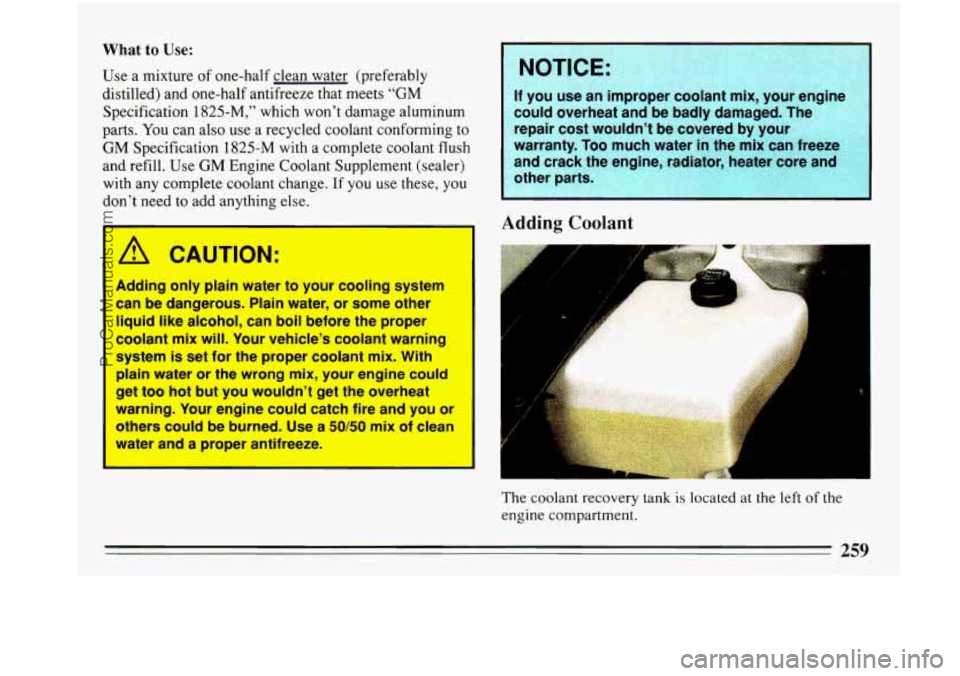
What to Use:
Use a mixture of one-half clean water (preferably
distilled) and one-half antifreeze that meets “GM
Specification
1825-M,” which won’t damage aluminum
parts.
You can also use a recycled coolant conforming to
GM Specification
1825-M with a complete coolant flush
and refill. Use GM Engine Coolant Supplement (sealer)
with any complete coolant change. If you use these, you
don’t need
to add anything else.
A CAUTION:
Adding only plain water to your cooling system
can be dangerous. Plain water, or some other
liquid like alcohol, can boil before the proper
coolant mix will. Your vehicle’s coolant warning
system
is set for the proper coolant mix. With
plain water or the wrong mix, your engine could
get too hot but you wouldn’t get the overheat
warning. Your engine could catch fire and you or
others could be burned. Use
a 50/50 mix of clean
water and a proper antifreeze.
If you use an improper coolant mix, your
engine :,,I could overheat and be badly damaged. The’: . -
repair cost wouldn’t be covered by your -.. - ’
warranty. Too much water in the mix can !ete;::
and crack the engine, radiator, heater
Core and
other parts.
~. -.- . ~. .. ..._ - . . :-: -. ~ . . ~.., -
Adding Coolant
6
The coolant recovery tank IS located at the left of the
engine compartment.
259
ProCarManuals.com
Page 266 of 340

that sooner or later your brakes won’t work well, or
won’t work at all.
So, it isn’t a good idea to “top off’
your brake fluid. Adding brake fluid won’t correct
a
leak. If you add fluid when your linings are worn, then
you’ll have
too much fluid when you get new brake
linings. You should add
(or remove) brake fluid, as
necessary, only when work is done
on the brake
hydraulic system.
I-
A CAUTION:
If you have too much brake fluid, it can spill on
the engine. The fluid will burn
if the engine is hot
enough. You or others could be burned, and your
vehicle could be damaged. Add brake fluid only
when work is done on the brake hydraulic
system.
When your brake fluid falls to a low level, your brake
warning light will come on and a chime will sound.
What to Add:
When you do need brake fluid, use only DOT-3 brake
fluid
-- such as Delco Supreme 11 @ (GM part
No.1052535). Use new brake fluid from a sealed
container only.
Replacing Brake System Parts
The braking system on a modern vehicle is complex. Its
many parts have to be
of top quality and work well
together if the vehicle is to have really good braking.
Vehicles we design and test have top-quality GM brake
parts in them, as your Buick does when it is new. When
you replace parts of your braking system
-- for example,
when your brake linings wear down and you have to
have new ones put
in -- be sure you get new genuine
GM replacement parts.
If you don’t, your brakes may no
longer work properly. For example,
if someone puts in
brake linings that are wrong for your vehicle, the
ProCarManuals.com
Page 277 of 340
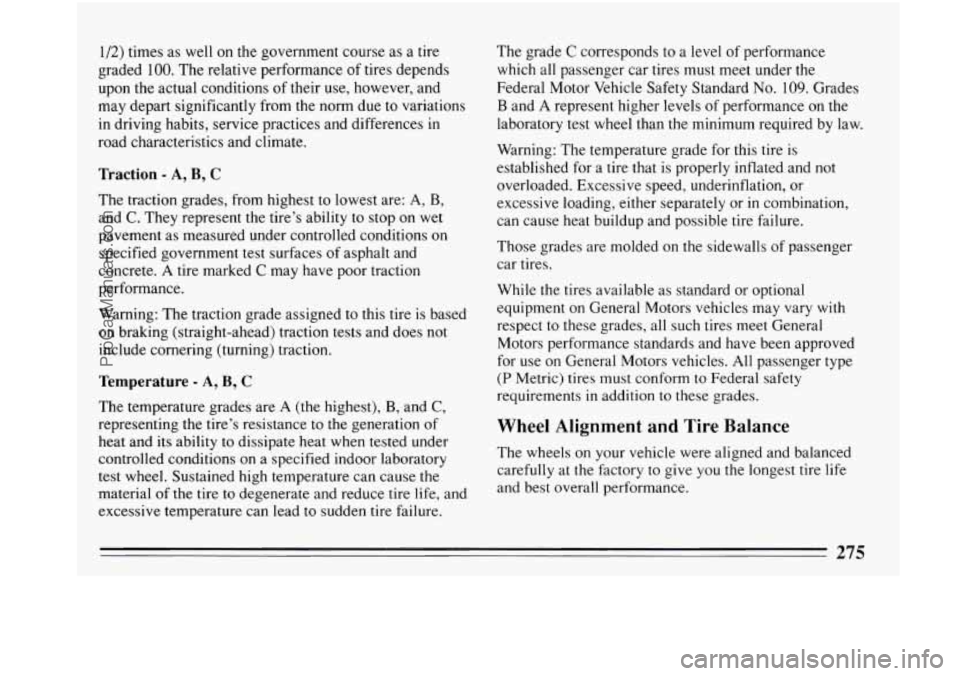
1/2) times as well on the government course as a tire
graded
100. The relative performance of tires depends
upon the actual conditions
of their use, however, and
may depart significantly from the norm due to variations
in driving habits, service practices and differences in
road characteristics and climate.
Traction - A, B, C
The traction grades, from highest to lowest are: A, B,
and C. They represent the tire’s ability to stop on wet
pavement as measured under controlled conditions
on
specified government test surfaces of asphalt and
concrete.
A tire marked C may have poor traction
performance.
Warning: The traction grade assigned to this tire is based
on braking (straight-ahead) traction tests and does not
include cornering (turning) traction.
Temperature - A, B, C
The temperature grades are A (the highest), B, and C,
representing the tire’s resistance to the generation of
heat and its ability
to dissipate heat when tested under
controlled conditions
on a specified indoor laboratory
test wheel. Sustained high temperature can cause the
material of the tire to degenerate and reduce tire
life, and
excessive temperature can lead to sudden tire failure. The grade
C corresponds to a
level of performance
which all passenger car tires must meet under the
Federal Motor Vehicle Safety Standard
No. 109. Grades
B and A represent higher levels of performance on the
laboratory test wheel than the minimum required by law.
Warning: The temperature grade for this tire is
established for a tire that is properly inflated and not
overloaded. Excessive speed, underinflation, or
excessive loading, either separately or in combination,
can cause heat buildup and possible tire failure.
Those grades are molded on the sidewalls
of passenger
car tires.
While the tires available as standard or optional
equipment on General Motors vehicles may vary with
respect to these grades, all such tires meet General
Motors performance standards and have been approved
for use on General Motors vehicles. All passenger type
(P Metric) tires must conform to Federal safety
requirements
in addition to these grades.
Wheel Alignment and Tire Balance
The wheels on your vehicle were aligned and balanced
carefully at the factory to give you the longest tire life
and best overall performance.
275
ProCarManuals.com